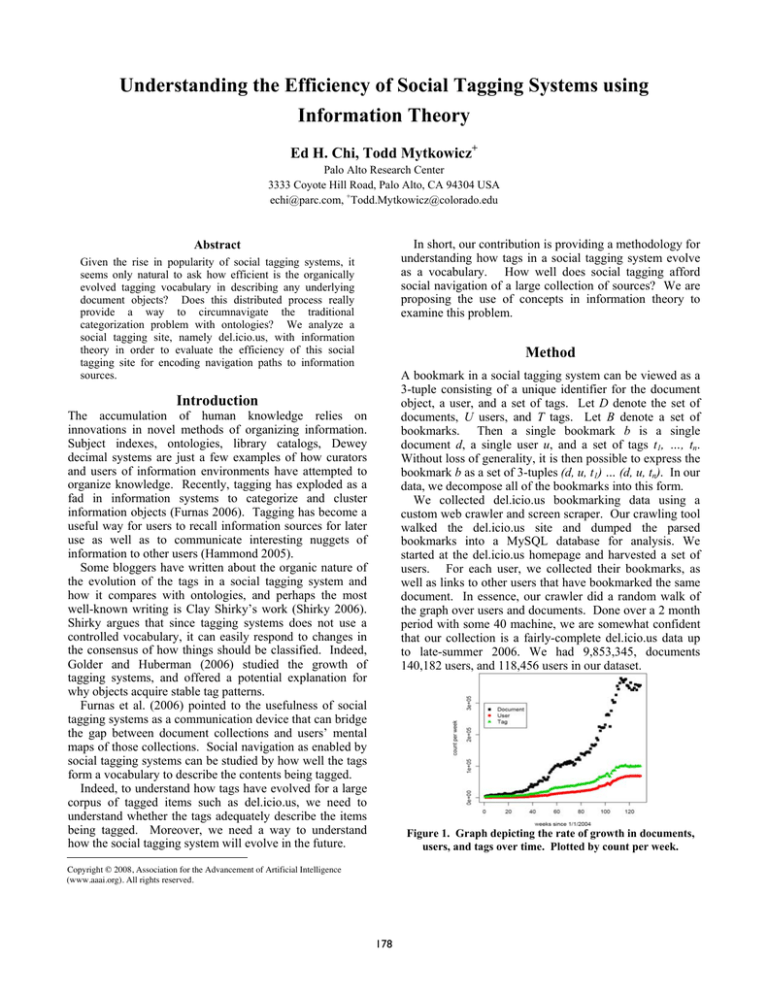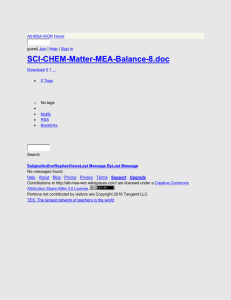
Understanding the Efficiency of Social Tagging Systems using
Information Theory
Ed H. Chi, Todd Mytkowicz+
Palo Alto Research Center
3333 Coyote Hill Road, Palo Alto, CA 94304 USA
echi@parc.com, +Todd.Mytkowicz@colorado.edu
In short, our contribution is providing a methodology for
understanding how tags in a social tagging system evolve
as a vocabulary. How well does social tagging afford
social navigation of a large collection of sources? We are
proposing the use of concepts in information theory to
examine this problem.
Abstract
Given the rise in popularity of social tagging systems, it
seems only natural to ask how efficient is the organically
evolved tagging vocabulary in describing any underlying
document objects? Does this distributed process really
provide a way to circumnavigate the traditional
categorization problem with ontologies? We analyze a
social tagging site, namely del.icio.us, with information
theory in order to evaluate the efficiency of this social
tagging site for encoding navigation paths to information
sources.
Method
A bookmark in a social tagging system can be viewed as a
3-tuple consisting of a unique identifier for the document
object, a user, and a set of tags. Let D denote the set of
documents, U users, and T tags. Let B denote a set of
bookmarks. Then a single bookmark b is a single
document d, a single user u, and a set of tags t1, …, tn.
Without loss of generality, it is then possible to express the
bookmark b as a set of 3-tuples (d, u, t1) … (d, u, tn). In our
data, we decompose all of the bookmarks into this form.
We collected del.icio.us bookmarking data using a
custom web crawler and screen scraper. Our crawling tool
walked the del.icio.us site and dumped the parsed
bookmarks into a MySQL database for analysis. We
started at the del.icio.us homepage and harvested a set of
users. For each user, we collected their bookmarks, as
well as links to other users that have bookmarked the same
document. In essence, our crawler did a random walk of
the graph over users and documents. Done over a 2 month
period with some 40 machine, we are somewhat confident
that our collection is a fairly-complete del.icio.us data up
to late-summer 2006. We had 9,853,345, documents
140,182 users, and 118,456 users in our dataset.
Introduction
The accumulation of human knowledge relies on
innovations in novel methods of organizing information.
Subject indexes, ontologies, library catalogs, Dewey
decimal systems are just a few examples of how curators
and users of information environments have attempted to
organize knowledge. Recently, tagging has exploded as a
fad in information systems to categorize and cluster
information objects (Furnas 2006). Tagging has become a
useful way for users to recall information sources for later
use as well as to communicate interesting nuggets of
information to other users (Hammond 2005).
Some bloggers have written about the organic nature of
the evolution of the tags in a social tagging system and
how it compares with ontologies, and perhaps the most
well-known writing is Clay Shirky’s work (Shirky 2006).
Shirky argues that since tagging systems does not use a
controlled vocabulary, it can easily respond to changes in
the consensus of how things should be classified. Indeed,
Golder and Huberman (2006) studied the growth of
tagging systems, and offered a potential explanation for
why objects acquire stable tag patterns.
Furnas et al. (2006) pointed to the usefulness of social
tagging systems as a communication device that can bridge
the gap between document collections and users’ mental
maps of those collections. Social navigation as enabled by
social tagging systems can be studied by how well the tags
form a vocabulary to describe the contents being tagged.
Indeed, to understand how tags have evolved for a large
corpus of tagged items such as del.icio.us, we need to
understand whether the tags adequately describe the items
being tagged. Moreover, we need a way to understand
how the social tagging system will evolve in the future.
Figure 1. Graph depicting the rate of growth in documents,
users, and tags over time. Plotted by count per week.
Copyright © 2008, Association for the Advancement of Artificial Intelligence
(www.aaai.org). All rights reserved.
1
178
Results
We first computed the frequency and then the
corresponding probability distribution of the documents
being bookmarked in the del.icio.us.
Using this
distribution we then generated the entropy curve for the tag
and document set.
The entropy of documents conditional on tags, H(D|T),
is increasing rapidly (see Figure 2). What this means is
that, even after knowing completely the value of tags, the
entropy of the document is still increasing. This measure
gives us a method for analyzing how useful a set of tags is
at describing a document set. The fact that this curve is
strictly increasing suggests that the specificity of any given
tag is decreasing.
Figure 4. Mutual Information I(T;D) decreases over time
showing that tags are becoming less descriptive for any
given document in del.icio.us. A value of 0 means complete
indepenence between Tags and the Documents those tags are
supposed to encode.
Discussion and Conclusion
We seek to understand the efficiency of shared tagging
vocabulary emerging from distributed social taggers on the
web. We used information theoretic measures to try to
quantify the complex dynamics in a social tagging site.
The result suggests that the quality of the shared mapping
between tags and documents in del.icio.us appears to be
getting noisier over time.
In order to increase the effectiveness of the encoding
process in del.icio.us, one needs to decrease H(D|T).
Given that H(D) is out of the control of the designer, all
that can be controlled explicitly via the designer's of
tagging software is H(T). Current tagging interfaces
usually provide ``popular tags'' when any individual user
attempts to encode a document. In effect, by providing this
facility to ease the encoding process for the tagger, the
designer's of tagging sites are causing H(T) to become less
diverse. Rather than providing popular tags for user's,
tagging sites should ask them to think of tags that describe
the document that are not in the popular list.
Figure 2. Entropy of Documents conditional on Tags H(D|T)
increases over time.
The conditional entropy H(T|D) asks the reverse question
of H(D|T) discussed in the previous section. “If I know a
set of document, what uncertainty remains in the tags that
are used to describe these documents?” Interestingly
enough, H(T|D) has been increasing steadily as shown in
Figure 3.
References
Furnas, G. W., Fake, C., von Ahn, L., Schachter, J.,
Golder, S., Fox, K., Davis, M., Marlow, C., and Naaman,
M. 2006. Why do tagging systems work?. In Proc. CHI '06
Extended Abstracts. ACM Press, New York, NY, 36-39.
Golder, S. and B. A. Huberman. (2006). Usage Patterns of
Collaborative Tagging Systems. Journal of Information
Science, 32(2). 198-208.
Figure 3. Conditional entropy H(T|D) increases over time.
Figure 4 illustrates the mutual-information I(X;Y) over
time. Mutual information is a measure of independence.
Full independence is reached when I(X;Y) = 0. As seen in
Figure 4 the trend is steep and quickly decreasing.
Hammond, T., T. Hannay, B. Lund, and J. Scott. Social
bookmarking tools : A general review. D-Lib Magazine,
11(4), April 2005.
Shirky, C. Ontology is Overrated: Categories, Links, and
Tags. Blog entry. http://shirky.com/writings/ontology
overrated.html (retrieved Sept 21, 2006).
179





